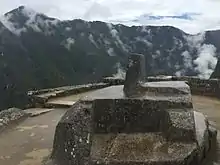Intihuatana, Urubamba
Intihuatana (possibly from in the Quechua spelling Inti Watana or Intiwatana)[1][2] at the archaeological site of Machu Picchu (Machu Pikchu) is a notable ritual stone associated with the astronomic clock or calendar of the Inca in South America. Machu Picchu was thought to have been built c. 1450 by the Sapa Inca Pachacuti as a country estate, although it is equally likely that the Inca discovered much older ruins (the inti watana, the temple of the sun, and the temple of the condor) and opted to build this majestic estate on older foundations. .[3][4] In the late 16th century, the Viceroy Francisco de Toledo and the clergy destroyed those Intihuatana which they could find. They did so as they believed that the Incas' religion was a blasphemy[5] and the religious significance of the Intihuatana could be a political liability. The Intihuatana of Machu Picchu was found intact by Bingham in 1911, indicating that the Spanish conquerors had not found it.[6]
 Intihuatana | |
| Alternative name | Hitching post of the Sun |
|---|---|
| Location | Peru |
| Region | Cusco Region, Urubamba Province |
| History | |
| Founded | c. 1450 (alternately, prehistory: >12,000 years ago) |
| Abandoned | ~ 1535 |
| Cultures | pre-Inca ("megalithic"); Inca |
| Associated with | up to 800 at peak |
Design
The Intihuatana of Machu Picchu was carved directly into the bedrock of the mountain's summit area. It is characterized by complex surfaces, planes and angles whose purpose at this time is unknown. Incomplete descriptions of its purpose by the Inca in their chronicles only add to its mysterious existence. Archeological explanations which are not currently mainstream assert that the Inca did not construct Inti Watana but rather found it, along with other mysterious structures pre-existing at Maccu Picchu. This implies a problematic consideration, that the Inti Watana's construction was done by an as-yet-unknown, apparently highly advanced earlier civilization. Current archeological thought has no rigorous explanation who this earlier culture could have been.[6] Featuring a slightly inclined plane at its top, an upright stone column tilts 13 degrees northward.[7] Other features include a granite block resembling a carved shelf, bench, or altar, and a rectangular base.[8]

Function
Possibly used as a sundial,[9] it was aligned with the sun's position during the winter solstice.[10] The Inca believed the stone held the sun in its place along its annual path in the sky. At midday on the equinoxes the sun stands almost above the pillar, casting no shadow at all. At midday on 11 November and 30 January, the sun stands almost exactly above the pillar, casting no shadow. On June 21, the stone is casting the longest shadow on its southern side and on December 21, a much shorter one on its northern side. The base is said to be "in the shape of a map of the Inca Empire" but most archaeologists disagree, observing that the base is squat and stubby whereas the Tawantinsuyu is long and thin.[10][11][12] Pedro Sueldo Nava describes the landmark as "perhaps one of the most beautiful and enigmatic places to be found in Machu Picchu."
See also
- Inti, the ancient Incan sun god
- Kusichaka River
- Machu Q'inti
- Pakaymayu
- Phutuq K'usi
- Wayna Pikchu
- Wayna Q'inti
- Sallqantay
References
- Teofilo Laime Ajacopa, Diccionario Bilingüe Iskay simipi yuyayk'ancha, La Paz, 2007 (Quechua-Spanish dictionary)
- Diccionario Quechua - Español - Quechua, Academía Mayor de la Lengua Quechua, Gobierno Regional Cusco, Cusco 2005 (Quechua-Spanish dictionary)
- "Machu Picchu History". www.destination360.com.
- "Pachacuti Inca Yupanqui - Inca emperor". britannica.com.
- Amao, Albert (23 January 2012). The Dawning of the Golden Age of Aquarius. AuthorHouse. pp. 79–. ISBN 978-1-4685-3753-6. Retrieved 19 July 2012.
- Krupp, E. C. (5 August 2003). Echoes of the Ancient Skies: The Astronomy of Lost Civilizations. Courier Dover Publications. pp. 48–. ISBN 978-0-486-42882-6. Retrieved 19 July 2012.
- Blacker, Maryanne (1 September 2010). DK Eyewitness Travel Guide: Peru. Penguin. pp. 181–. ISBN 978-0-7566-8326-9. Retrieved 19 July 2012.
- Zecharia Sitchin (31 October 2011). "Zecharia Sitchin - The Lost Realms". slideshare.net.
- Amao, Albert (24 January 2012). The Dawning of the Golden Age of Aquarius: Redefining the Concepts of God, Man, and the Universe. AuthorHouse. p. 78. ISBN 978-1-4685-3752-9. Retrieved 16 July 2012.
- Jenkins, Dilwyn (1 October 2003). Rough Guide to Peru. Rough Guides. p. 175. ISBN 978-1-84353-074-9. Retrieved 16 July 2012.
- "Archived copy". Archived from the original on 2014-03-23. Retrieved 2014-03-23.CS1 maint: archived copy as title (link)
- "Archived copy". Archived from the original on 2006-09-16. Retrieved 2014-03-23.CS1 maint: archived copy as title (link)
| Wikimedia Commons has media related to Intihuatana (Machu Picchu). |